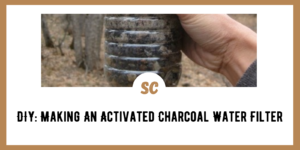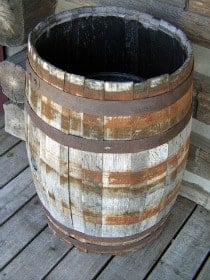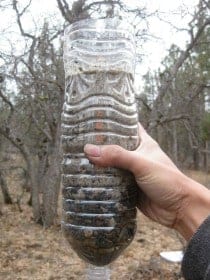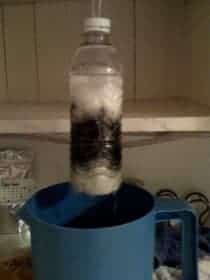We’ve had a lot of rain up here lately. A LOT of rain. I was out puttering around the yard this week and I noticed the rainwater slowly dripping through my raised fire pit and the wood coals it was full of. Drip drip drip…… into a puddle below.
SKIP AHEAD
Do It Yourself Activated Charcoal Filter
That got me thinking, is that some kind of charcoal filter happening there? What is the difference between a pile of wood charcoal and an activated charcoal filter? Can I make an activated charcoal filter to filter water through for drinking?
The first thing I learned when I started searching for the answers to those questions, is that activated charcoal is in no way the same as a burnt wood. Activated charcoal is charcoal that has been treated with oxygen to open up millions of tiny pores between the carbon atoms. It’s a specialized manufacturing process, requiring temperatures in the 1000 degree F range. (Or really dangerous chemicals and temperatures in the 600-degree range.)
Well, shoot. There went my whole DIY activated charcoal plans. What can I still do? Make charcoal? I’m quite the pyro, I burn a fair bit of wood. How far will that get me towards a water filter?
It turns out, that regular charcoal was used for water filtering for a long time before we figured out No products found.. In its natural state, it contains the atoms that neutralize odors and filter water. Activated charcoal just has those atoms in larger quantities. (For those interested in such things, apparently activated charcoal made from coconut shells is better than that made from wood.)
So regular charred wood will work. Just not as well. You can increase the amount of regular charcoal, or increase the contact time of the water to charcoal to make up for the lesser effectiveness. And remember, there are specific ways to make good charcoal. Check this out.
To recap here, I don’t think you can make your own Activated Charcoal, especially not for less than what you can find for it online. And probably not safely, considering the temperatures involved. But, if you want a DIY water filter, you can buy the Activated charcoal and DIY everything else.
You need to plan your filter to allow proper time for the AC to adsorb the contaminants, the water has to be in contact with the carbon filter for longer than a second. You’ll also want a sediment filter before the activated charcoal filter since they don’t work as well for the bigger particles.
Sediment filters can be fine sand or gravel. The sediment filter will grab things like sand and rust particles. Don’t send boiled water immediately through an AC filter, it works best at room temperature.

|
|
Check Price on Amazon.com
|
More Info
Here’s a great PDF (Click Here) from my neighbors to the North, the North Dakota State University. “Filtration: Sediment, Activated Carbon and Mixed Media” If you are looking for a good overview of your various DIY options for water filtration.
They start with a good reminder to get your water tested so you KNOW for sure, exactly what kinds of things you’ll need to be filtering out. No, this is not a service that will be available post grid crash. Yes, you should get this done before that happens. Then expect your water quality to get worse post-crash, not better. See Road Warrior’s post from SHTFBlog.com for one of the reasons why (Click Here).
Think of your filtering needs as layers. The sediment filter removes things like rust and sand. The AC filter removes or reduces organics that can affect the taste, odor, and color, chlorine, trihalomethanes (THM), pesticides, industrial solvents (halogenated hydrocarbons), polychlorinated biphenyls (PCBs), and polycyclic aromatic hydrocarbons (PAHs). A round of Ultraviolet (UV) treatment can be done quite simply with clear 1 L plastic water bottles set in the sun for a few hours. UV will remove a lot of microorganisms that could make you sick, microorganisms that an AC filter won’t catch.
Check out this doc (Click Here) for a great 101 on UV water treatment. They’ve got a great chart on UV dosages required to kill a whole list of organisms, Bacteria, mold, viruses, and yeasts.
Remember to account for filter replacement. If you want 3 months’ worth of water filtration, but your rate of water usage means you’ll need to replace the filter every 2 weeks, you’ll have to have 6 replacement filters on hand. Your rate of water usage can be calculated by taking the Number of People x Average Daily Water Usage.
And remember to count your people correctly, will your son’s best friend who lives with a dead-beat dad be over every day? Will your brother-in-law bring his family out to your place if the city loses water/power? Your water usage number will be a gallons/day number. Most filters will tell you how many gallons of water they can filter before cleaning or replacement is necessary. So Filter Life divided by your Usage Rate will tell you how many days that filter will last at that rate.
Keep that Usage Rate in mind when you are designing the system. Do you have a place to hold the needed water, before and after filtering? If you know you’ll need 12 gallons a day, do you want to hold 6 at a time and filter twice a day? Or hold 24 gallons and filter once every 2 days?
If you find you need some small parts, there are kits online with just those small parts that you can buy. Like this one.

|
|
Check Price on Amazon.com
|
What kinds of water purification do you have planned? Anyone working on some DIY Filters? The last time I made one was in high school, for an aquaculture class. It could be a good time to revisit that experience and see what I can whip up for my family. Sound off in the comments below if you have ideas or actual plans that you’ve followed.
Photos by: Brenda Price, Calamity Jane, James Moore, Ryo Chijiiwa
Open Questions on Activated Carbon Water filter
Can regular charcoal be used to filter water?
While it is possible that regular barbequing charcoal would have some absorption properties, it is also likely that it would leach contaminants into your water. This is due to the fact that it isn’t made for this purpose, and may contain harmful agents that aren’t safe to drink.
If you don’t have activated charcoal available, making your own basic charcoal out of burnt hardwood would be a better alternative to regular barbeque charcoal.
Both these types of charcoal are far, far less effective at filtering water and aren’t a suitable substitute for properly activated charcoal.
If you have used activated charcoal previously and find yourself needing to use regular charcoal in an emergency situation, it is important to understand that they are not interchangeable.
This is because regular charcoal can absorb far less than activated charcoal and also takes much longer to work.
That being said, some sort of purification is usually better than none at all.
How long does an activated charcoal filter last?
It’s important to have some idea of how long an activated charcoal filter will last, in order to prevent the level of filtration and protection it offers from decreasing without you knowing.
There is some variance depending on the specific filter you’re using and you should always check the manufacturer instructions that accompany the particular filter. With that said, most commercial activated charcoal filters will last anywhere from 2 to 6 months from their first usage. DIY filters may not last as long as these professionally made filters and will be more variable.
The amount of time filters last depends on a few different factors, such as frequency of usage and the quality of the water you’re filtering. Naturally, the more pollutants that are filtered out, the more the charcoal filter will absorb, reducing its absorption capacity.
Most companies will provide an amount of water or time that the filters should be able to last, however, these are not guaranteed to be accurate due to the factors mentioned previously.
What can activated charcoal absorb?
Activated charcoal can absorb many different types of pollutants including, toxins, viruses, fungus, bacteria, and chemicals.
While the specific impurities and pollutants that can be absorbed are too vast to list, filtering water using activated charcoal offers an excellent amount of protection from water-borne threats.
Some of the best industrial water purification processes in the world use charcoal filtering as a stage in their filtering process, such is its effectiveness.
However, filtering water using activated charcoal might not remove all impurities and pollutants. This is extremely important to note. When it comes to water purification, multiple stages of filtration are the surest way to improve the quality of water and make it as safe as possible.
Using multiple steps, such as filtering and then boiling water further reduces the chance of any lingering contaminants posing a danger to you.
What’s the difference between activated charcoal and regular charcoal?
High-grade activated charcoal is typically made from coconut shells as this provides a better quality of charcoal. The thing that really separates activated charcoal from regular charcoal is how pure they are, and how activated charcoal is treated.
Since regular charcoal isn’t intended for any use except burning as a fuel, it can contain binding chemicals that help it to perform its role as a fuel more effectively. These agents would likely be harmful to you if they were to come in contact with your water supply.
The key difference is that activated charcoal is processed using extreme heat and sometimes other chemicals to ‘activate’ it. This means that roughly one spoonful of activated charcoal has a surface area equivalent to around 6 or 7 football fields.
It is this massive surface area that is able to attract and trap pollutants and is what makes it so much more efficient and longer-lasting than regular charcoal.
Can I wash my carbon filter?
Carbon filters are only effective as long as their massive microscopic surface areas have the capacity to absorb new particles. This will naturally make you wonder whether it is possible to prolong the life of your filter by cleaning it or removing these particles.
While it is important to keep your filter clean, it isn’t possible to extend the lifespan of your filter by removing particles it has already absorbed. Any cleaning agents you hope to remove these particles will only further contaminate your filter, so it’s a bit of a catch twenty-two.
If your filter is dirty, dusty, or needs debris removing from it, your best bet is to submerge your filter in the cleanest water you have available. This will wash away this unwanted filth without needlessly using up your filter’s precious absorption capacity.
Can activated charcoal kill viruses?
Technically, charcoal filters don’t kill pollutants, whether it’s a virus or other impurity. Charcoal filters simply trap these particles on its highly absorbent surface to prevent them from contaminating the air or water it is filtering.
With that said, activated charcoal filters can absorb and protect from a wide range of threats, from viruses to bacteria and fungi.
It is even used in medicine to help treat overdoses of certain drugs and poisons. However, as with viruses, charcoal doesn’t truly kill or negate these particles, it simply absorbs them to prevent them from interacting with other nearby particles.





